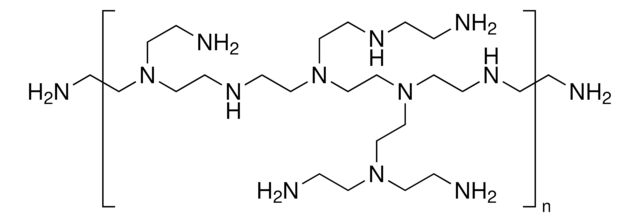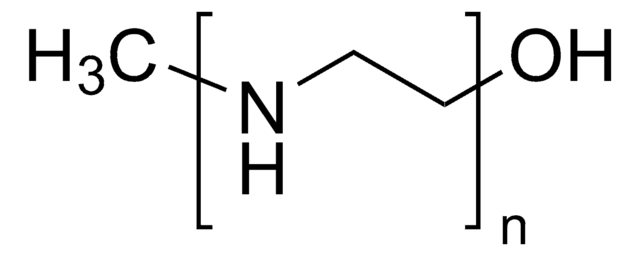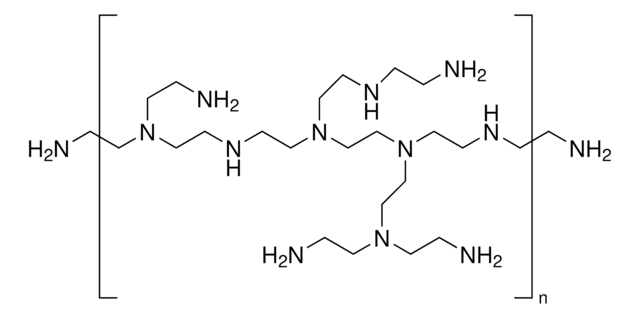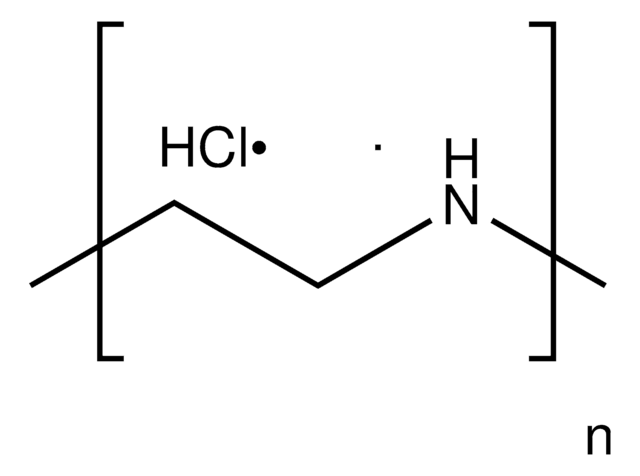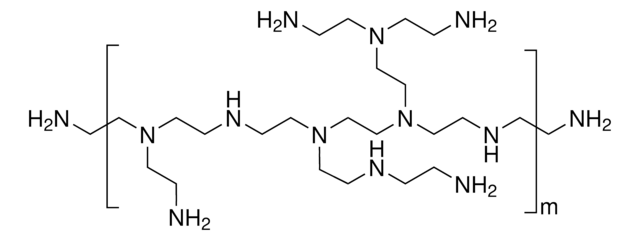408727
Polyethylenimine, branched
average Mw ~25,000 by LS, average Mn ~10,000 by GPC, branched
Recommended Products
form
viscous liquid
mol wt
average Mn ~10,000 by GPC
average Mw ~25,000 by LS
impurities
≤1% water
refractive index
n20/D 1.5290
viscosity
13,000-18,000(50 °C)
bp
250 °C (lit.)
density
1.030 g/mL at 25 °C
SMILES string
C1CN1
InChI
1S/C2H5N/c1-2-3-1/h3H,1-2H2
InChI key
NOWKCMXCCJGMRR-UHFFFAOYSA-N
Looking for similar products? Visit Product Comparison Guide
Related Categories
General description
Application
PEI can be used to functionalize single-walled nanotubes (SWNTs) to improve their solubility and biocompatibility while maintaining the structural integrity of the original SWNT. Covalently functionalized SWNTs find application in CO2 absorption and gene delivery.
Branched PEI can also be used to modify the surface properties of adsorbents. PEI-modified hydrous zirconium oxide/PAN nanofibers are used for the defluorination of groundwater as they show high fluoride adsorption capacity and a wide working pH range.
Features and Benefits
Branched PEI has better complexation andbuffering capacity.
Physical form
Signal Word
Warning
Hazard Statements
Precautionary Statements
Hazard Classifications
Acute Tox. 4 Oral - Aquatic Chronic 2 - Eye Irrit. 2 - Skin Sens. 1
Storage Class Code
10 - Combustible liquids
WGK
WGK 2
Personal Protective Equipment
Certificates of Analysis (COA)
Search for Certificates of Analysis (COA) by entering the products Lot/Batch Number. Lot and Batch Numbers can be found on a product’s label following the words ‘Lot’ or ‘Batch’.
Already Own This Product?
Documents related to the products that you have purchased in the past have been gathered in the Document Library for your convenience.
Difficulty Finding Your Product Or Lot/Batch Number?
How to Find the Product Number
Product numbers are combined with Pack Sizes/Quantity when displayed on the website (example: T1503-25G). Please make sure you enter ONLY the product number in the Product Number field (example: T1503).
Example:
Additional examples:
705578-5MG-PW
PL860-CGA/SHF-1EA
MMYOMAG-74K-13
1000309185
enter as 1.000309185)
Having trouble? Feel free to contact Technical Service for assistance.
How to Find a Lot/Batch Number for COA
Lot and Batch Numbers can be found on a product's label following the words 'Lot' or 'Batch'.
Aldrich Products
For a lot number such as TO09019TO, enter it as 09019TO (without the first two letters 'TO').
For a lot number with a filling-code such as 05427ES-021, enter it as 05427ES (without the filling-code '-021').
For a lot number with a filling-code such as STBB0728K9, enter it as STBB0728 without the filling-code 'K9'.
Not Finding What You Are Looking For?
In some cases, a COA may not be available online. If your search was unable to find the COA you can request one.
Which document(s) contains shelf-life or expiration date information for a given product?
If available for a given product, the recommended re-test date or the expiration date can be found on the Certificate of Analysis.
How do I get lot-specific information or a Certificate of Analysis?
The lot specific COA document can be found by entering the lot number above under the "Documents" section.
What is the concentration and purity of Polyethylenimine, Product 408727?
This product is the pure product of polyethyleneimine. At room temperature this product is a liquid and not a solid. The purity of this product is not routinely determined.
At what temperature does Product 408727, Polyethylenimine, decompose?
Polyethylenimine (mw ~25,000) begins to decompose at 225 °C.
What is the solubility of Product 408727, Polyethylenimine?
We do not test the solubility of this product. However, according to our supplier, this product is miscible with water and ethylene glycol, and soluble in ethanol.
What are the end groups on Product 408727, Polyethylenimine?
The end groups are primary, secondary, and tertiary amines that are in a ratio of 1 : 1.2 : 0.76, respectively.
What is the water content of Product 408727, Polyethylenimine?
This product will contain less than 1% water. The lot specific value is reported on the Certificate of Analysis.
How do I find price and availability?
There are several ways to find pricing and availability for our products. Once you log onto our website, you will find the price and availability displayed on the product detail page. You can contact any of our Customer Sales and Service offices to receive a quote. USA customers: 1-800-325-3010 or view local office numbers.
What is the Department of Transportation shipping information for this product?
Transportation information can be found in Section 14 of the product's (M)SDS.To access the shipping information for this material, use the link on the product detail page for the product.
My question is not addressed here, how can I contact Technical Service for assistance?
Ask a Scientist here.
Articles
New methods for materials fabrication at the micro- and nanoscale will drive scientific and technological advances in areas of materials science, chemistry, physics, and biology. The broad diversity of potentially relevant materials, length scales, and architectures underscores the need for flexible patterning approaches. One important example is the fabrication of 3D periodic structures composed of colloidal, polymeric, or semiconductor5 materials.
Professor Yoshiki Katayama (Kyushu University, Japan) discusses recent advances in drug delivery systems and strategies that exploit the EPR effect, with a special focus on stimuli-responsive systems based on novel materials.
Gene therapy has become one of the most discussed techniques in biomedical research in recent years.
We present an article that discusses two applications in particular; first, using these layers as polyelectrolyte membranes to control permeability.
Our team of scientists has experience in all areas of research including Life Science, Material Science, Chemical Synthesis, Chromatography, Analytical and many others.
Contact Technical Service